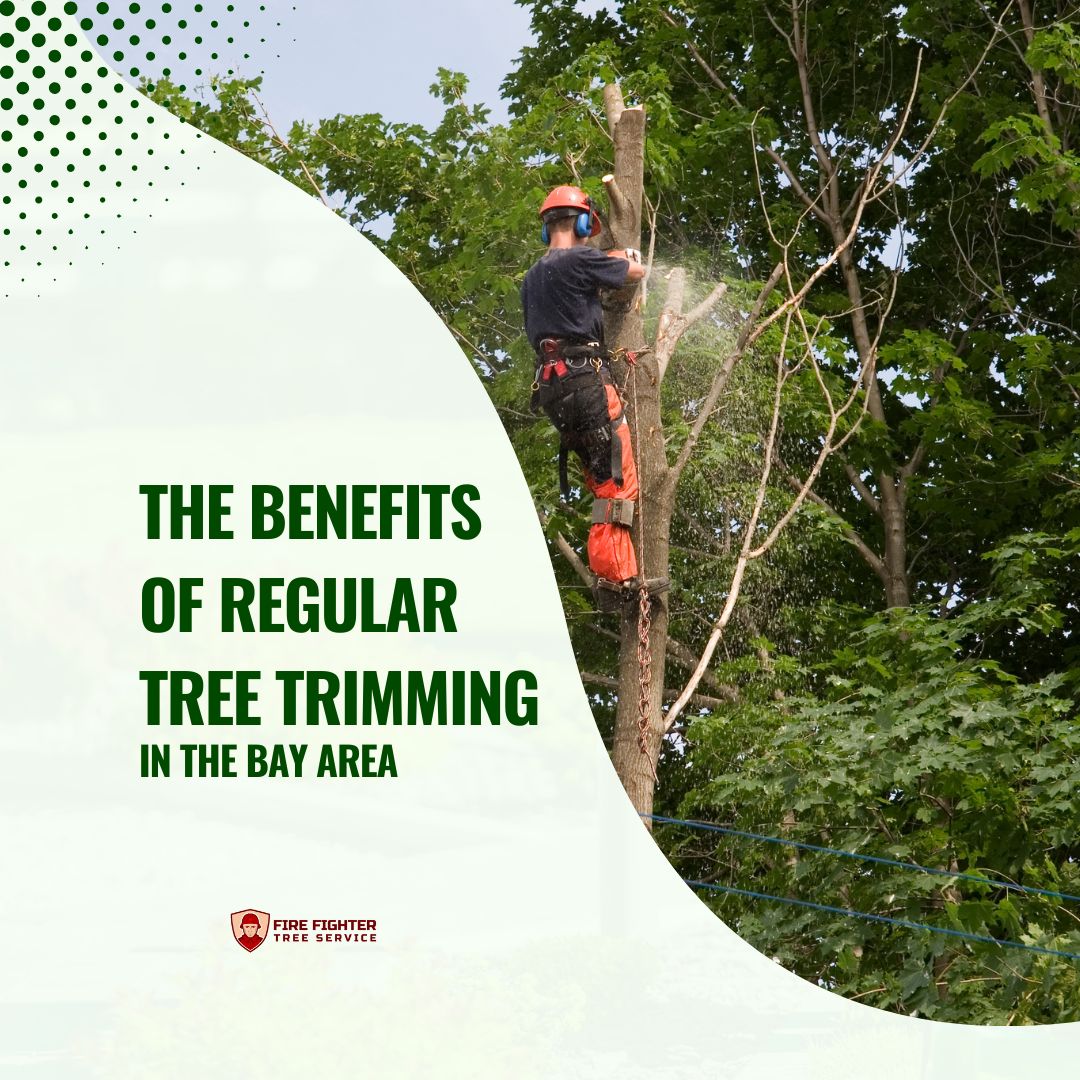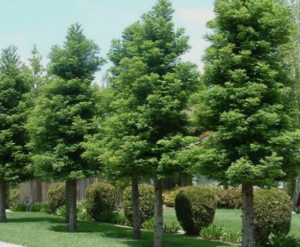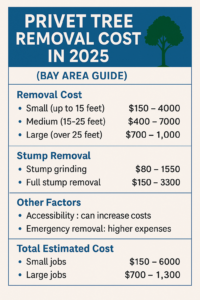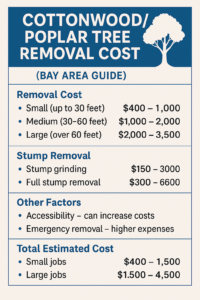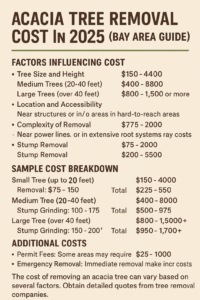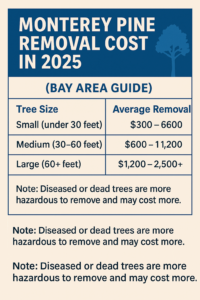Trimming involves removing damaged, overgrown, and diseased branches from trees and shrubs. This practice improves the tree’s health and safety and your property’s curb appeal. Regular tree trimming also boosts fruit production and prevents wildfire risks, which can be widespread in the Bay Area. This guide explains the benefits of regular tree trimming in the Bay Area and addresses the unique challenges.
Table of Contents
- Why Regular Tree Trimming is Important
- Key Benefits of Regular Tree Trimming
- Unique Bay Area Challenges for Tree Trimming
- FAQs
- Conclusion
Why Regular Tree Trimming is Important
The Bay Area has experienced over 500 wildfire incidents over the last six decades. Who knows? Perhaps some of the fires could have been suppressed by regular tree trimming or pruning.
But why prune trees?
Untrimmed trees usually create a perfect path for spreading fires, while damaged and dry branches fuel the fire. Regular tree trimming can prevent such incidents. It thins the overgrown canopies and removes the deadwood, preventing fires from spreading.
Another common environmental challenge in the Bay Area that calls for regular tree trimming is coastal winds. Strong winds break and damage tree branches, tear flowers and leaves, and sometimes uproot trees. However, with regular Bay Area tree trimming, the risk of the strong winds damaging the trees is lower.
Also, the Bay Area’s dense urban population means improved air quality is needed. Trimming encourages better air circulation around the branches, reducing overcrowding and allowing the trees to breathe well. Understanding such tree care benefits should motivate you to trim trees regularly.
Key Benefits of Regular Tree Trimming
Five benefits stand out from regular tree trimming in the Bay Area.

1. Improves Tree Health
Trimming removes dead and diseased branches and prevents them from affecting the rest. That allows the tree to redirect its energy away from the affected parts and focus on newer, healthier branches. This is one of the key trimming or pruning benefits for growth.
Trimming also improves sunlight penetration and air circulation, which is necessary for the tree’s health. It reduces vast canopies, allowing sunlight to penetrate and reach the leaves. It’s on the leaves that photosynthesis (the process of making food) happens, leading to a healthy tree.
Regarding air circulation, trimming ensures adequate room for air circulation around the branches and leaves by reducing branch overcrowding. Such actions prevent tree diseases by discouraging pest infestation and fungal attack.
Moreover, regular tree health maintenance practices like trimming boost the tree’s structural integrity. The tree develops robust branches and frameworks to contain its weight and withstand environmental forces like coastal winds.
2. Enhances Safety
Overgrown and broken branches are a safety risk during stormy winters. They can fall on powerlines, buildings, and other structures and cause severe damage. Even worse, they could fall on people and claim lives. Hence, there’s a need for safe tree care practices like trimming.
Regular trimming practices prevent branch hazards, thus minimizing the risk. They allow you to remove the branches before they can fall. The trimming also allows the tree to grow into a better shape and boost its integrity, enabling it to withstand stormy conditions.
Tree trimming for safety also means maintaining a safe distance between the branches and the powerlines. For example, the recommended clearance from distribution lines for high-fire-threat districts (HFTDs) is 4 feet but 12 feet at pruning. Meanwhile, for non-high-fire-threat districts (non-HFTDs), it is 18 inches.
3. Increases Curb Appeal
Beautiful tree trimming improves a property’s aesthetics. It allows you to remove overgrown and dead branches, giving the trees a more symmetrical and visually appealing look. That makes your property more inviting, which makes it appear even more attractive to prospective buyers.
Regular trimming ensures no branches fall off, messing up your yard space or walkways or damaging the outdoor structures. Furthermore, it preserves the views. Since there are no branches overcrowding, there are no obstructed views, making your property more aesthetic.
Harmonizing the trimming with the best landscaping ideas is essential to boost property value. That includes the following aesthetic tree care:
- Mulching: Applying a ring of mulch at the base of the tree to slow down erosion and prevent weeds
- Edging: Adding an edge of bricks, stones, or metal to define the space and retain mulch
- Timely pruning: Do it before the tree starts to bud to encourage faster regeneration
- Flower pops: Plant some flowers around the trees to inject some pop and vibrancy
4. Boosts Fruit Production

By removing unneeded branches, trimming allows fruit trees to redirect energy to healthy budding areas, which leads to the production of more and healthier fruits. Apart from that, removing diseased branches prevents the spread of diseases between branches, which often affects fruit production. Once the branches are free from diseases and pests, it’s easy for the tree to increase fruit yield.
Also, trimming prevents fungi and pest attacks by reducing overcrowding and encouraging air circulation, which leads to better fruit quality. Even better, the practice promotes sunlight penetration by reducing branch overcrowding, which boosts fruit production.
Healthy fruit tree care, which includes regular trimming, allows the tree to maintain a specific, manageable size, which makes harvesting less stressful.
Understanding the Bay Area’s climate is essential to knowing when to trim for maximum fruit gain. Below are seasonal tips for pruning fruit trees in the Bay Area.
- Consider the dormant period for major trimming: During the dormant period (late December to early February), fruit trees have already shed their leaves, making them perfect for cutting overgrown and diseased branches.
- Do light pruning in the summer: The summer is perfect for trimming highly vigorous shoots and new suckers.
Below is a table showing the different seasons to prune fruit trees in the Bay Area:
| Fruit Tree Category | Tree Example | Ideal Pruning Season |
| Stone fruit trees | Peach and plum trees | Light pruning in early spring or late winter and major pruning from December to February |
| Deciduous fruit trees | Apple, apricot, pear, plum, and cherry trees | |
| Evergreen fruit trees | Citrus, blueberry, and avocado trees |
5. Prevents Wildfire Risks
While wildfire incidents in the Bay Area could be due to various reasons, such as climate change and increased developments in wildland-urban interfaces (WUIs), part of the reason is poor suppression strategies. That’s where trimming comes in. It can help reduce fire hazards.
Trimming removes overgrown and dry branches that serve as fire fuel. Dead and overhanging branches catch fire quickly and allow the fire to spread quickly.
Trimming allows the creation of a natural fire break by interfering with the continuity of trees. Once there’s no continuity in trees, it’s hard for wildfires to spread. The dry branches no longer touch each other, which stops fire from spreading between them.
Ideally, the defensible space protocols insist on clearing flammable plant life within 30 feet of structures and keeping tree branches at least 10 feet apart. If the fire doesn’t stop, this defensible space maintenance approach effectively slows it down, which reduces possible damage.
Of course, there are many other ideas for wildfire prevention tree care, such as thinning and debris clearance, but trimming is among the most efficient.
Unique Bay Area Challenges for Tree Trimming
Bay Area homeowners face several challenges in trimming their trees. These unique Bay Area tree care challenges are worth knowing beforehand so you can know what steps to take to address them. They include the following:

1. Drought Stress
Drought stress occurs when the water is insufficient to support tree growth. It could result in low rainfall, high temperatures, or salinity. Tree species like the acacia and Monterey pines are more susceptible to drought stress.
Though plants require regular trimming during drought stress, it has to be strategic, and that’s where the challenge lies. It’s best to prune when the trees are dormant. While at it, don’t over-prune. Over-pruning the trees could force them to lose even more water, which could kill them.
Other drought-stressed tree solutions include:
- Controlling weeds which compete with the trees for moisture
- Mulching to retain soil moisture
- Controlling pests that stress the trees
- Planting drought-tolerant varieties like almond, pine, oak, apricot, cedar, cherry, plum, fig, or olive tree
2. Salt Exposure from Coastal Air
The Bay Area’s coastal wind carries some salinity, affecting trimming. Trees tend to grow only on the sides shielded from salt spray. Furthermore, salt spray attacks the leaves and changes their morphology, so to avoid further damage to the tree, it’s advisable to trim it as often as possible.
3. Urban Encroachment
With most residents in the Bay Area living in urban areas, there’s a need to create more green spaces and promote ecological balance. Also, local governments are enforcing regulations to restrict tree work in urban areas, especially tree removal and excessive trimming of some species, such as Black Walnut, Redwood, and California Oak trees. Ordinarily, you need a permit before you can bring down such varieties.
The other challenge is that of space. With people living close to each other in the urban Bay Area, there’s not enough space to trim trees. Some are even close to power lines, making it difficult to prune them. In such cases, contacting professional tree-trimming service providers is advisable. Experts have the right equipment, such as cranes, to do a good job while prioritizing everyone’s safety. They also understand what urban tree maintenance is all about and could offer advice.
4. Strong Winds
The Bay Area is also prone to strong winds, which lead to frequent tree breakages and the falling of weak branches, which are a safety risk. It’s advisable to remove the weak and broken branches before they pose a threat to your safety, and that’s where regular inspections and trimming are essential.
5. Accessibility Challenges

Some trees in the Bay Area offer limited access. Either they are too close to distribution lines and structures or poorly planted. Such trees require expert knowledge and equipment to trim them. Also, you may need to consult a certified electrician if a power line is involved.
6. Leaning Trees
It’s common to see trees leaning towards structures and power lines in the Bay Area. While trimming such trees is essential, it’s even more advisable to do it early to guide their growth. Leaning trees pose a safety risk as they are almost inaccessible without the right equipment. Hence, this is another case to call a professional tree trimming company.
FAQs
How often should trees be trimmed in the Bay Area?
The tree trimming schedule in the Bay Area primarily depends on the tree species and season. Deciduous species like apples and pears are best trimmed in early spring or late winter when they are dormant. Evergreen varieties like citrus and avocado are best trimmed immediately after flowering. Also, the pruning frequency depends on how often there are safety concerns. Do it when you notice broken or overgrown branches.
Is tree trimming necessary during droughts?
Light trimming, which may involve removing diseased and damaged branches, is necessary during droughts, as it helps the tree conserve moisture and prevents the branches from rubbing due to water stress. However, major pruning for water conservation isn’t advisable, as that could lead to excessive moisture loss. Observetree care during drought so as not to stress the tree.
Can I trim my trees myself?
You can trim your trees yourself if it’s only light trimming work, such as removing broken and dry branches. However, it can be risky when it’s a major project. Common DIY tree trimming risksinclude being hit by falling trees or branches, electrocution, and equipment accidents.
Instead of doing it yourself, consider professional tree care for major trimming work. It’s safe that way as the experts are knowledgeable, employ safer techniques, and use effective equipment. Additionally, the results are impressive.
Conclusion
Regular tree trimming is essential to ensure healthy trees and safe space. However, it can be overwhelming trying to get a reliable tree-trimming company in the Bay Area. Firefighter Tree Service stands out because of the extensive experience working with the local community. Besides, we understand the best techniques for pruning different tree species in your locality. Get in touch with us today for a customized tree trimming quote.
